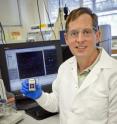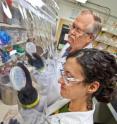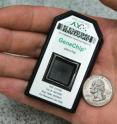CSI: Microbial version without PCR
Related images
(click to enlarge)
Anyone who has watched one of the CSI: Crime Scene Investigation television shows knows that PCR (Polymerase Chain Reaction) is a technology used to amplify the tiniest samples of DNA into forensic evidence that can identify perpetrators or victims of a crime. Microbiologists also use PCR to uncover the identity of microbes in samples taken from a wide range of sources for a wide range of purposes. However, for microbial analysis, the use of PCR technology can pose problems. Now, researchers with the U.S. Department of Energy (DOE)'s Lawrence Berkeley National Laboratory (Berkeley Lab) have overcome those problems with the development of PCR-free technology that is based on Berkeley Lab's award-winning, high-density DNA-based microarray known as the PhyloChip. "We've developed two methods of PCR-independent microbial community analysis using the PhyloChip," says Gary Andersen, a microbial ecologist with Berkeley Lab's Earth Sciences Division. "Each method represents a simple and economical way to directly query microbial communities in natural environments and each offers the additional advantage of detecting the most metabolically active microbes in a community, the ones most likely to attenuate toxins, drive biogeochemical cycles or proliferate in disease states."
Andersen is the corresponding author of a paper published in the journal Applied and Environmental Microbiology that discusses this research. The paper istitled "PCR amplification-independent methods for detection of microbial communities by the high density microarray PhyloChip." Co-authoring the paper were Kristen DeAngelis, Cindy Wu, Harry Beller, Eoin Brodie, Romy Chakraborty, Todd DeSantis, Julian Fortney, Terry Hazen, Shariff Osman, Mary Singer and Lauren Tom.
How omnipresent are microbes in the environment? Extract a gram of soil from just about anywhere and you can expect to find many millions of individual microbes representing more than a thousand different taxa. On land or in water, from tropical forests to backyard compost heaps, these microbial communities are the primary drivers of numerous ecosystem processes via their ability to decompose organic matter or catalyze important chemical reactions.
"With such complexity at the heart of so many ecosystem processes, there is a great need to be able to reliably and affordably analyze microbial communities in samples from different environments," Andersen says.
Scientists identify the individual microbial taxa in a sample via the genetic signatures of ribosomal RNA (rRNA), which is the genetic component of the ribosome, the machinery within a biological cell that makes proteins. PCR technology has typically been used to amplify the DNA in a sample to obtain a sufficient amount of genetic material for analysis.
"PCR amplification of microbial DNA introduces well-known distortions," says Kristen DeAngelis, lead author of the AEM paper who is now with the University of Massachusetts but remains a collaborator with the Joint BioEnergy Institute (JBEI), a DOE Bioenergy Research Center, which is led by Berkeley Lab. "For example, DNA extracted from natural environments may include DNA from microbial populations that are dead, dormant, or otherwise not directly contributing to an ecosystem's function."
Andersen, DeAngelis and their colleagues on this project were able to eliminate the need for problematic PCR amplification by using the PhyloChip. Developed by AEM paper co-authors Andersen, DeSantis and Brodie, plus Yvette Piceno, all with Berkeley Lab's Earth Sciences Division, the PhyloChip is a square-shaped microarray chip the size of a quarter. The latest version is packed with more than a million individual probes and can be used to quickly, accurately and comprehensively detect the presence of up to 50,000 different species of bacteria and archaea in a single sample from any environmental source, without the need of culturing.
Winner of an R&D 100 Award in 2008, the PhyloChip identifies individual microbial species on the basis of the 16S rRNA gene, which is present in all microbes.
"Small regions of DNA base-pair sequence differences within the 16S rRNA gene can be used to distinguish different microbial species," Andersen says. "Because this gene encodes an integral structural component of the ribosome, it is tied directly to a microbe's metabolic activity."
In their first PCR-free analytical method, the Berkeley Lab researchers directly placed microbial rRNA on the PhyloChip. This offered the simplest and least biased view of the most metabolically active members of the microbial community in the sample.
"The rRNA can be thought of as the first responders to a changing set of environmental conditions that result in an increase or decrease in demand for new proteins," Andersen says. "Essentially, the greater the demand for new proteins, the greater the concentration of rRNA in the cell. This can be used as a measure of metabolic activity to show what microbes are responding the fastest to a new set of conditions. Slight changes in nucleotide sequences, analogous to changes in a bar code, are used to differentiate one organism from another."
One drawback to this method is that RNA binds much more tightly to the PhyloChip probes than is typical for DNA. This results in increased background noise and variability that can pose challenges. In response, the Berkeley Lab researchers developed a second PCR-free method in which the rRNA is replaced with a complementary DNA sequence (cDNA). The cDNA complement is then synthesized to create a double-stranded cDNA fragment that closely mirrors the properties of a PCR amplified 16S rRNA gene fragment.
"This approach has the advantages of decreased background noise and variability while maintaining a faithful representation of the naturally occurring, metabolically active microbial communities," Andersen says. "The choice of which of these two PCR-free methods to use is case-by-case. Some samples work fine with the simple and direct rRNA method while others require the additional steps of the double-stranded cDNA method."
Andersen, DeAngelis and their colleagues successfully tested their two new PCR-free analysis techniques by comparing results with PCR-amplified DNA tests using a mock community of eight microbial taxa in three environmental sample types: chromium-contaminated aquifer groundwater; tropical forest soil; and secondary sewage in sea water.
"Community profiles produced by our alternative methods showed taxa differences that would be expected based on accompanying data, but were missing in PCR-amplified communities," DeAngelis says. "Our result show that a
PCR-independent view of microbial communities can potentially change which microbes we think are dominant in an ecosystem. At JBEI, for example, we can use these new methods to identify microbes that are most active in breaking down feedstock biomass, such as switchgrass, into sugars that can be synthesized into advance biofuels."
This research was supported by the DOE Office of Science.
Recommend this story on Facebook, Twitter,
and Google +1:
Source: DOE/Lawrence Berkeley National Laboratory
Other sources
- CSI: Microbial version without PCRfrom Science DailyWed, 21 Sep 2011, 21:30:24 UTC
- CSI: PCR-free techniques ID the most active microbes on the scenefrom PhysorgWed, 21 Sep 2011, 19:31:01 UTC


